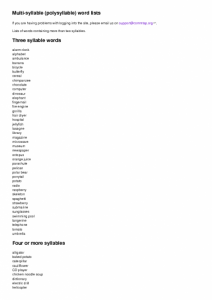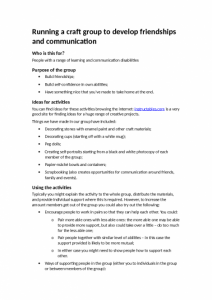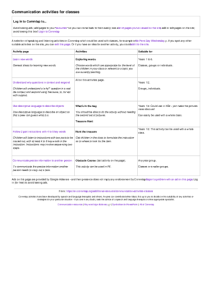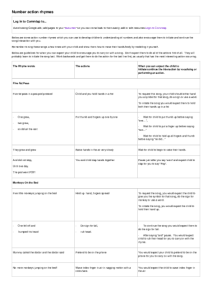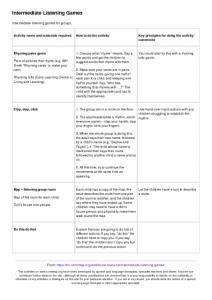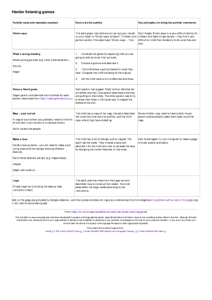Search
User login
Topic “Large group or a class”
Contains activities or strategies suitable for use in a large group or in a class.
Multi-syllable (polysyllable) word lists
Lists of words containing more than two syllables.
Three syllable words
alarm clock
alphabet
ambulance
banana
bicycle
butterfly
cereal
chimpanzee
chocolate
computer
dinosaur
elephant
fingernail
fire engine
gorilla
hair dryer
hospital
jellyfish
lasagne
library
magazine
microwave
museum
newspaper
octopus
orange juice
parachute
pelican
polar bear
ponytail
potato
radio
raspberry
skeleton
spaghetti
strawberry
submarine
sunglasses
swimming pool
Running a craft group to develop friendships and communication
This provides suggestions for developing friendships and communication skills through running a craft group: particularly suitable for adults with a range of learning disabilities.
Created 21 July 2015.
Recall a sequence of three or more activities in the right order
| Activity/strategy name and materials required | How to do the activity | Key principles for doing the activity and comments |
|---|---|---|
| Recall what happened in a lesson The materials you had in the lesson. Picture prompts for the activities that were carried out. Piece of card to stick the prompts onto as you do the activities in the lesson. |
| You can work on recall of the main activities in the lesson, for example:
Strategies you could use if the student is finding this difficult: At the end of one activity say we were "listening", next we will draw a picture. Show a prompt card for each - so the student can see the progression from one activity to another. Ask them about these two activities at the end of the second one. |
Robert's Friend
One day there was a boy called Robert. He was starting at a new school. On his first day, he met lots of children in his class. At playtime, he went outside with everyone else. Some children played football. Some children played hopscotch. Some children ran around and played tag. Robert wished he could play. He didn’t know anybody yet.
Communication activities for classes
A selection of speaking and listening activities on Commtap which could be used with classes, for example on No Pens Day Wednesday. If you spot any other suitable activities on the site, you can edit this page. Or if you have an idea for another activity, you could add it to the site.
Communication activities for classes
Created 12 September 2012; updated 11 May 2023.
Understand and use ordinals (1st, 2nd, 3rd etc)
| Activity/strategy name and materials required | How to do the activity | Key principles for doing the activity and comments |
|---|---|---|
| Write it Writing materials |
| This works best 1:1. Use this activity only with a child who can read and write. With children with less good literacy skills, you will need to talk about what you are going to focus on, but miss out the written support. With children who can cope with larger numbers, you might want to go beyond 10, be careful to explain how numbers such as 21st, 22nd and 23rd are formed. |
| Line up None | This works best with a class or group. You may want to focus more on the front of the line. | |
| PE Equipment as required by the PE activity | This works best with a class. | |
| Small World Small world equipment, including several ‘people’. | This works best 1:1. This activity is more suited to younger children. | |
| Actions Equipment as required by the actions. Visual prompt cards if required. | This works best 1:1 or with a small group. Make sure you stress words such as “first”, “second” etc. Bear in mind the child’s auditory memory – the more instructions you give, the harder it will be to remember them. |
Learn new words
| Activity/strategy name and materials required | How to do the activity | Key principles for doing the activity and comments |
|---|---|---|
| Exploring words Written word with a picture Written sounds for beginning/ end of each word Visuals for the story Dictionary (maybe)
| Ideas you can use to help word learning - you do not need to use all of them, and some will work better than others for different children. 1. Introduce the written form of the word; 2. Say the word to the child and ask for repetition; 3. Ask the child to clap syllables on your or their hands, use prompting if necessary. Or alternatively they could tap the syllables out on pictures of drums (say four arranged in a row); 4. Ask if any other words rhyme with this new word (think of examples yourself) - you could take this in turns in a group; 5. Ask for beginning and ending sounds; 6. Tell the child a short story or anecdote, including the word as the main feature if possible - or work with the child to work a story out; 7. Give an explicit definition (school dictionary maybe - some dictionaries are more helpful than others for this!) and give context(s) preferably first one being the one used in the story as it’s familiar but make sure to offer other contexts; 8. Ask the child if they can put the word in a sentence/ tell a short story including the word; 9. If ability allows, ask the child if they know of any word which means a similar thing. | These activities help to build a child’s vocabulary with solid representations of words. It gives a child strategies to use when learning and remembering new words. It builds the child’s confidence on a topic, especially if taught before the relevant lesson. |
Number action rhymes
Below are some action number rhymes which you can use to develop children’s understanding of numbers and also encourage them to initiate and continue the song/interaction with you.
Remember to sing these songs a few times with your child and show them how to move their hands/body by modelling it yourself.
Intermediate Listening Games
Intermediate listening games for groups.
Support Commtap to keep it online
Thank you for visiting Commtap.
Please read this message as it is extremely important.
- Visitor donations mean we can continue to host over 1,000 free activities to support speech, language, and communication development.
- Visitor donations mean we can continue to provide free resources to address a wide range of communication needs, including limited speech or language, interaction challenges, and needs associated with conditions such as developmental language disorder, autism, and cerebral palsy.
- Visitor donations mean we can continue to provide resources to support the work of speech and language therapists, teachers, teaching assistants, parents, and carers.
- Visitor donations mean we can continue to provide the free key word sign dictionary (bks.org.uk) which has over 2,000 Makaton and Signalong signs.
We know that not everyone is able to afford to pay to access these resources, however, if you can, please make a donation to keep the site going.
Thank you
Google ads on this page are provided by Google Adsense - and their presence does not imply any endorsement by Commtap. Report a problem with an ad on this page. Log in (for free) to avoid seeing Google ads.
